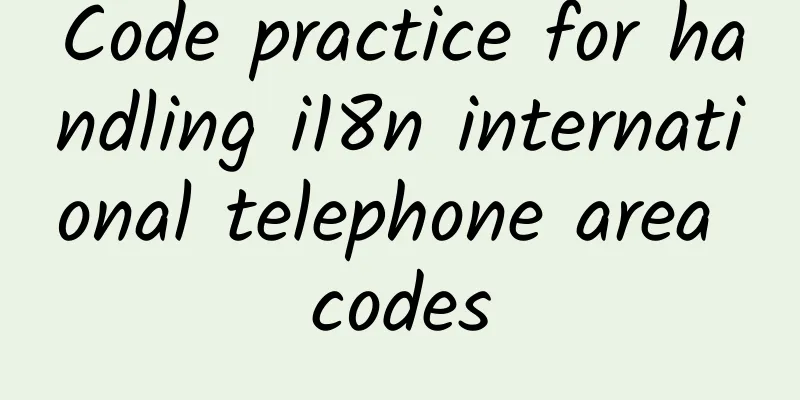Code practice for handling i18n international telephone area codes

PrefaceLast week, I was busy with the internationalization (i18n) of the product. One of the important aspects is the internationalization of phone numbers (we use phone numbers as the main account). A very important part of the phone number is the area code. The above picture is the login interface of our product. In addition to the regular phone number, there is also an area code in front of it, which represents the country and region the phone number belongs to. For the concept of area codes, please refer to Wikipedia. Seeing this, some people may wonder what's so difficult about this? Isn't it just displaying it in a list? There are several problems with this.
So we will do this work locally, but iOS has already done part of the work for us. We can get the localized name of a country or in the current region based on the country code. //Get the current locale Let's do a simple test NSArray *countryArray = [NSLocale ISOCountryCodes]; result zh_CN AD Andorra Now that we have introduced some of the work that iOS does for us, we have to do the other part ourselves. We need a list of regions->area codes, but this is also simple. I found a lot of them online. The file content is as follows (diallingcode.json) [ Maintaining such a table is very simple. We can store it locally or on the server (the "name" field is actually not necessary, it's just for appearance) ResearchLet's put the code aside for now and see how other products do it This is WeChat WeChat still has a lot of problems
This is Twitter Twitter is still weird in Chinese, but it didn’t make WeChat’s second mistake What about Facebook? Their engineers are smart (lazy) and they don’t support indexing at all Next we will solve these problems CodeFirst, create a Modal to display country-related information. @interface MMCountry : NSObject Then we need to read the area code from the configuration file and create an index using the area code as the key NSData *data = [NSData dataWithContentsOfFile:[[NSBundle mainBundle] pathForResource:@"diallingcode" ofType:@"json"]]; Then get the local dialect names of these countries NSLocale *locale = [NSLocale currentLocale]; It should be noted here that the Latin culture of letters solves the second problem of WeChat, so that non-basic Latin letters can also be sorted according to basic Latin letters. The function is as follows - (NSString*)latinize:(NSString*)str There are two steps here
Let's test whether these two steps will result in the same effect as before. NSArray *countryArray = [NSLocale ISOCountryCodes]; result zh_CN AD Andorra | an dao er You can see that the system will convert different expressions of the same country into different Latin letters according to the characteristics of different countries and languages. Next, we classify the acquired data according to 'A'-'Z' NSMutableDictionary *dicSort = [@{} mutableCopy];*** Rearrange the order of the data under each category for ( NSString *key in dicSort.allKeys ) In this way, dicSort is the result set we finally get
Let’s take a look at the final result Is it better than WeChat? discussAlthough the code is written, the problem has not been solved. A key question is why do we need to sort by 'A'-'Z'? For example, Twitter in Japanese and Korean environments is like this In fact, the best solution is to index according to the language characteristics of different countries (PS: seeing the poor results of Twitter in the Chinese environment, I am not sure whether its results in Japanese and Korean are correct (¯﹃¯) summaryThe demo in this article can be found here As mentioned in the discussion, the solution discussed in this article is not the final solution. If you need a better experience, you need to study the culture of each country in depth. Therefore, internationalization is not just a technical issue, but also a social project~~~~ |
<<: How I Doubled My Pickup Rates as a Coder
>>: How should tool apps operate?
Recommend
High-end TVs have become a trend. What is the significance of quantum dots for the consumption upgrade of China's electronics market?
On April 13, the "2017 International Quantum...
Calcium supplement, blood supplement, brain supplement...are these hidden "nutrition kings" on your table?
As people pay more and more attention to health c...
What is Xiaomi’s plan to implant the “Mary Sue” gene into the feverish spirit?
At the Xiaomi 5X launch conference, Lei Jun made a...
Guangzhou's self-driving taxi trial operation was halted, and the pre-operation application was not approved
The self-driving taxi project, which began trial ...
How many days will Guangxi have a holiday on March 3rd in 2022? Is it the lunar calendar or the new calendar? Attached is the holiday schedule!
March 3rd is a traditional festival for many ethn...
Understand "World Traditional Medicine Day" in 80 seconds!
I am Dongdongmiao. World Traditional Medicine Day...
How to select high-quality APP promotion channels?
With the rapid development of the mobile Internet...
What is the real reason for customer churn?
In today's brand marketing stage where produc...
How to build an Android MVVM application framework
Overview When it comes to Android MVVM, I believe...
Android phones are booming this year
In the past two years, the rapid development of A...
How does stomach cancer develop from eating one bite at a time? Check yourself for these 6 situations!
As our lives get better and better, people no lon...
Bugs that don’t bite are all alike, but bugs that bite each have their own weapons!
Author: Ji Qiaoqiao (Northeast Institute of Geogr...
Russian taxi drivers complain about Chinese cars. Is this a prejudice of trolls or a solid fact?
The rise of China's auto industry and the sur...
Hummingbird: "I have the same beak as your flower"
In nature, although the hummingbirds and flowers ...
How to awaken the product’s communication power? Share 6 methods!
Once the product is made, the big challenge is ho...









